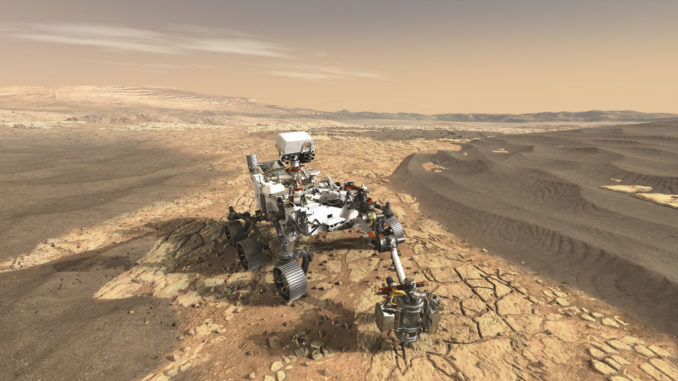
NASA’s Mars 2020 rover has a new name: Perseverance. The name was announced live online, yesterday (March 5) at about 1:40pm EST/10:40am PST.
Perseverance will be the fifth rover NASA has sent to the Red Planet. The previous four were Sojourner (1997), Spirit (2004), Opportunity (2004), and Curiosity (2012).
All five rovers were named through nationwide contests open to school-age children, kindergarteners through twelfth grade. The Mars 2020 naming contest officially began August 28, 2019, and received 28,000 entries which were narrowed to 155 semifinalists by almost 4,700 volunteer judges, then further reduced to nine finalists. The public then cast over 770,000 votes to voice their opinion. The nine finalists (three from K-4, three from 5-8, three from 9-12) were interviewed by a NASA panel of experts before the final decision was made. The names suggested by the nine finalists were:
- Endurance
- Tenacity
- Promise
- Perseverance
- Vision
- Clarity
- Ingenuity
- Fortitude
- Courage
The student who submitted the winning entry, Perseverance, was revealed live at his school by NASA officials. Seventh grader Alexander Mather had a rather big day in his young life, reading aloud the essay he wrote for the contest entry to the cheers of his classmates. Alex and his family have been invited to be NASA’s guests at the launch of Perseverance, with the trip paid for by Amazon Web Services. The launch window to put Perseverance into orbit and on to Mars opens July 17 and closes August 5. Touchdown on Mars is slated for February 18, 2021.
Perseverance, like its immediate predecessor Curiosity, is about the size of a car at 3 meters (10ft) long, 2.7 meters (9ft) wide, 2.2 meters (7ft) high. But Perseverance weighs 1,025 kilograms (2,260 pounds) which is 126 kilograms (278 pounds) heavier than Curiosity. Perseverance is also improved in many ways and will be setting down in Jezero Crater on rougher terrain than any previous Mars lander or rover.
One of the most interesting aspects of the mission is MOXIE:
The Mars Oxygen In-Situ Resource Utilization Experiment (MOXIE), a technology demonstration that will produce oxygen from Martian atmospheric carbon dioxide. If successful, MOXIE’s technology could be used by future astronauts on Mars to burn rocket fuel for returning to Earth. The principal investigator is Michael Hecht, Massachusetts Institute of Technology, Cambridge, Massachusetts.
NASA, Mars 2020 Fact Sheet (PDF)
Question of the night: Which of the nine finalist names do you think was best?

2 Trackbacks / Pingbacks
Comments are closed.